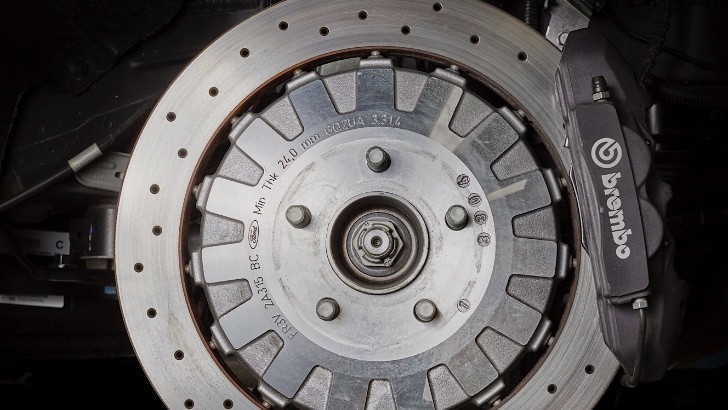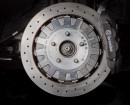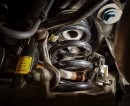Whenever the Shelby badge is glued to a Mustang's exterior shell, the average petrolhead knows that serious firepower is hiding far from sight, waiting to be unleashed at a press of a pedal.
There's a lot of tech fitted beneath the car, so we though a simple guide on how the suspension, chassis and braking work in the new Ford Shelby GT350 might prove useful.
That being said, let's take each feature separately and explain it's role and mechanism in detail.
However, the Shelby Mustang features and aluminum front knuckle, hub and bearing assemblies that are stiffer and lighter compared to their standard alternatives.
Also, rigid bushings are fitted to the control arms and subframes in an attempt to improve steering feedback. A new set of heavy-duty bearings is added for increased lateral stiffness while body control is enhanced via front and rear antiroll bars.
And now, here come the stars of the suspension system: the continuously variable MagneRide dampers. Alright, but how do they work? Quite simple: these parts are filled with hydraulic fluid containing iron particles, so each time an electric current is passed through the liquid, near-instantaneous adjustment of the suspension performance is carried out.
But here's the icing on the cake, according to Ford: "with wheel position sensors monitoring motion thousands of times per second combined with other vehicle data, changes can be made to each corner every 7 milliseconds for optimum handling performance."
Front end stiffness was also upgraded by using a new lightweight aluminum tower brace that connects the shock towers and firewall. Other than that, engineers redesigned the grille opening reinforcement with a carbon fiber composite arrangement 24 percent lighter than in the standard Ford Mustang.
The Shelby GT350 was therefore fitted with two-piece cross-drilled iron rotors with aluminum hats, which also happen the be the largest rotors ever installed on a Ford. The front ones measure 394-millimeter and the rear ones 380-millimeter; engineers pin-drove them to the aluminum hats to significantly reduce heat transfer to the bearings.
Six-piston Brembo-sourced calipers are tasked with biting the discs with integrated caliper bridges at the front and four pistons at the rear.
We must also mention the car's carbon fiber 19-inch wheels (11 inch wide at the front, 11.5 inches at the back). They come fitted with custom formulated Michelin Pilot Sport Cup 2 tires and manage to kill approximately 50 pounds (22 kg) of unsprung weight.
Hopefully, after reading this, you'll have a better idea on how a standard Ford pony car can become, with the right tune up, a fierce track tool.
That being said, let's take each feature separately and explain it's role and mechanism in detail.
1. Suspension
Ford says the Shelby GT350 features a heavily revised suspension, for maximum cornering performance. But that's PR talk as far as we're concerned.However, the Shelby Mustang features and aluminum front knuckle, hub and bearing assemblies that are stiffer and lighter compared to their standard alternatives.
Also, rigid bushings are fitted to the control arms and subframes in an attempt to improve steering feedback. A new set of heavy-duty bearings is added for increased lateral stiffness while body control is enhanced via front and rear antiroll bars.
And now, here come the stars of the suspension system: the continuously variable MagneRide dampers. Alright, but how do they work? Quite simple: these parts are filled with hydraulic fluid containing iron particles, so each time an electric current is passed through the liquid, near-instantaneous adjustment of the suspension performance is carried out.
But here's the icing on the cake, according to Ford: "with wheel position sensors monitoring motion thousands of times per second combined with other vehicle data, changes can be made to each corner every 7 milliseconds for optimum handling performance."
2. Chassis
For the new Shelby GT350, torsional stiffness has been increased by 28% percent compared to the previous model. This way, the suspension geometry remains consistent even under the stress caused by those moments when corners are hit at high speed.Front end stiffness was also upgraded by using a new lightweight aluminum tower brace that connects the shock towers and firewall. Other than that, engineers redesigned the grille opening reinforcement with a carbon fiber composite arrangement 24 percent lighter than in the standard Ford Mustang.
3. Brakes
One might argue that reducing unsprung mass in vital in a performance model, and that's obviously true. However, braking is equally important, and a compromise must be made to achieve balance.The Shelby GT350 was therefore fitted with two-piece cross-drilled iron rotors with aluminum hats, which also happen the be the largest rotors ever installed on a Ford. The front ones measure 394-millimeter and the rear ones 380-millimeter; engineers pin-drove them to the aluminum hats to significantly reduce heat transfer to the bearings.
Six-piston Brembo-sourced calipers are tasked with biting the discs with integrated caliper bridges at the front and four pistons at the rear.
We must also mention the car's carbon fiber 19-inch wheels (11 inch wide at the front, 11.5 inches at the back). They come fitted with custom formulated Michelin Pilot Sport Cup 2 tires and manage to kill approximately 50 pounds (22 kg) of unsprung weight.
Hopefully, after reading this, you'll have a better idea on how a standard Ford pony car can become, with the right tune up, a fierce track tool.





